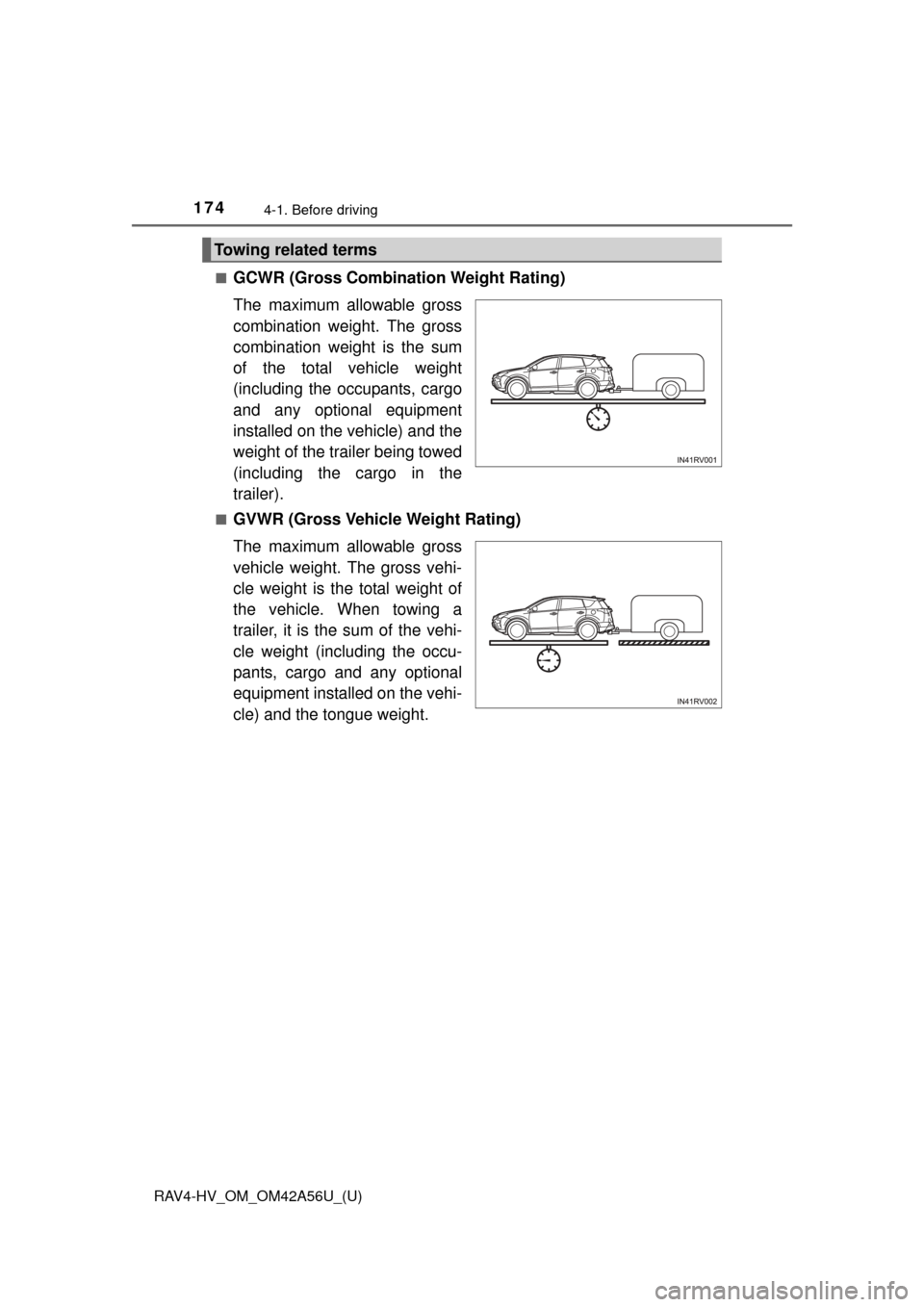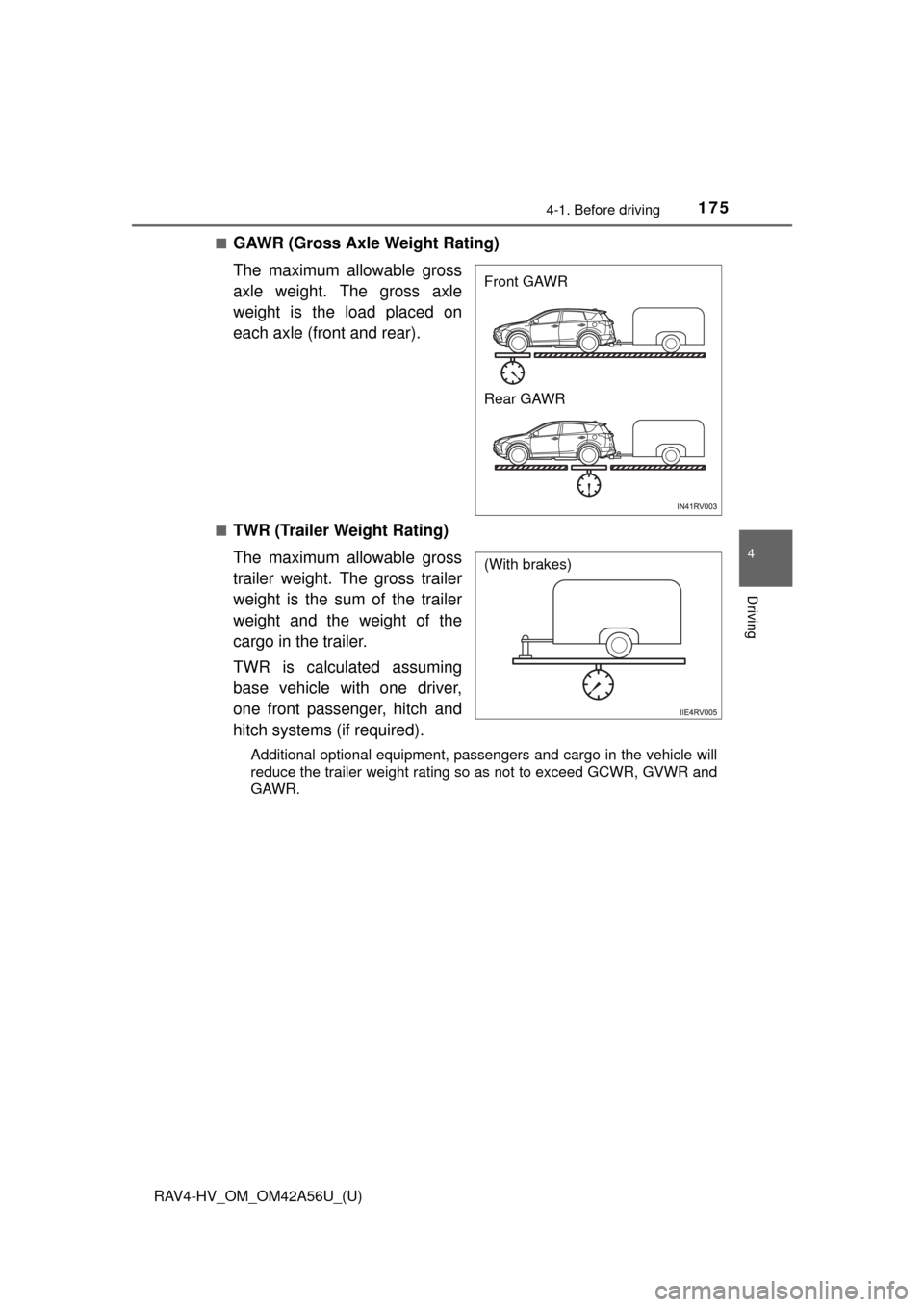2016 TOYOTA RAV4 HYBRID trailer
[x] Cancel search: trailerPage 3 of 660

3
RAV4-HV_OM_OM42A56U_(U)
1
9 8
7
6 4 3
2
10
5
4-1. Before drivingDriving the vehicle ............. 158
Cargo and luggage............ 168
Vehicle load limits ............. 172
Trailer towing..................... 173
Dinghy towing.................... 187
4-2. Driving procedures Power (ignition) switch ...... 188
EV drive mode................... 193
Hybrid transmission........... 195
Turn signal lever................ 199
Parking brake .................... 200
4-3. Operating the lights and wipers
Headlight switch ................ 201
Automatic High Beam ....... 205
Fog light switch ................. 210
Windshield wipers and washer ..................... 211
Rear window wiper and washer ..................... 215 4-4. Refueling
Opening the fuel tank cap................................... 218
4-5. Using the driving support systems
Toyota Safety Sense P ...... 221
PCS (Pre-Collision System) ........................... 228
LDA (Lane Departure Alert with steering control) ....... 243
Dynamic radar cruise control.............................. 252
Cruise control .................... 264
Intuitive parking assist ....... 268
Rear view monitor system ............................. 276
BSM (Blind Spot Monitor)......... 286
• The Blind Spot Monitor function.......................... 290
• The Rear Cross Traffic Alert function ................. 293
Driving assist systems ....... 296
4-6. Driving tips Hybrid vehicle driving tips ................................... 302
Winter driving tips .............. 305
Utility vehicle precautions ...................... 309
4Driving
Page 157 of 660

157
RAV4-HV_OM_OM42A56U_(U)
4Driving
4-1. Before drivingDriving the vehicle ............. 158
Cargo and luggage ........... 168
Vehicle load limits ............. 172
Trailer towing..................... 173
Dinghy towing ................... 187
4-2. Driving procedures Power (ignition) switch ...... 188
EV drive mode .................. 193
Hybrid transmission........... 195
Turn signal lever................ 199
Parking brake .................... 200
4-3. Operating the lights and wipers
Headlight switch ................ 201
Automatic High Beam ....... 205
Fog light switch ................. 210
Windshield wipers and washer ..................... 211
Rear window wiper and washer ..................... 215 4-4. Refueling
Opening the fuel tank cap .................................. 218
4-5. Using the driving support systems
Toyota Safety Sense P ..... 221
PCS (Pre-Collision System) ........................... 228
LDA (Lane Departure Alert with steering control) ....... 243
Dynamic radar cruise control ............................. 252
Cruise control .................... 264
Intuitive parking assist....... 268
Rear view monitor system ............................ 276
BSM (Blind Spot Monitor) ........ 286
• The Blind Spot Monitor function ......................... 290
• The Rear Cross Traffic Alert function ................. 293
Driving assist systems ...... 296
4-6. Driving tips Hybrid vehicle driving tips .................................. 302
Winter driving tips ............. 305
Utility vehicle precautions ..................... 309
Page 159 of 660

RAV4-HV_OM_OM42A56U_(U)
1594-1. Before driving
4
Driving
Make sure that the parking brake is set and shift the shift lever to D.
Gently depress the accelerator pedal.
Release the parking brake.
■When starting off on a uphill
The hill-start assist control will activate. ( P. 296)
■ For fuel-efficient driving
Keep in mind that hybrid vehicles are similar to conventional vehicles, and it
is necessary to refrain from activities such as sudden acceleration. ( P. 302)
■ Driving in the rain
●Drive carefully when it is raining, because visibility will be reduced, the win-
dows may become fogged-up, and the road will be slippery.
● Drive carefully when it starts to rain, because the road surface will be espe-
cially slippery.
● Refrain from high speeds when driving on an expressway in the rain,
because there may be a layer of water between the tires and the road sur-
face, preventing the steering and brakes from operating properly.
■ Engine speed while driving
In the following conditions, the engine speed may become high while driving.
This is due to automatic up-shifting control or down-shifting implementation to
meet driving conditions. It does not indicate sudden acceleration.
●The vehicle is judged to be driving uphill or downhill
● When the accelerator pedal is released
● When the brake pedal is depressed while sport mode is selected
■ Breaking in your new Toyota
To extend the life of the vehicle, observing the following precautions is recom-
mended:
●For the first 200 miles (300 km):
Avoid sudden stops.
● For the first 500 miles (800 km):
Do not tow a trailer.
● For the first 600 miles (1000 km):
• Do not drive at extremely high speed.
• Avoid sudden acceleration.
• Do not drive continuously in low gears.
• Do not drive at a constant speed for extended periods.
Starting off on a steep uphill
1
2
3
Page 168 of 660

168
RAV4-HV_OM_OM42A56U_(U)
4-1. Before driving
Cargo and luggage
Cargo capacity depends on the total weight of the occupants.
(Cargo capacity) = (Total load capacity) (Total weight of occupants)
Steps for Determining Correct Load Limit
(1) Locate the statement “The combined weight of occupants and cargo should never exceed XXX kg or XXX lbs.” on your vehicle’s
placard.
(2) Determine the combined weight of the driver and passengers that will be riding in your vehicle.
(3) Subtract the combined weight of the driver and passengers from
XXX kg or XXX lbs.
(4) The resulting figure equals the available amount of cargo and lug- gage load capacity.
For example, if the “ XXX” amount equals 1400 lbs. and there will be
five 150 lb passengers in your v ehicle, the amount of available
cargo and luggage load capacity is 650 lbs. (1400 750 (5150) =
650 lbs.)
(5) Determine the combined weight of luggage and cargo being loaded on the vehicle. That weight ma y not safely exceed the available
cargo and luggage load capacity calculated in Step 4.
(6) If your vehicle will be towing a tr ailer, load from your trailer will be
transferred to your vehicle. Consult this manual to determine how
this reduces the available cargo and luggage load capacity of your
vehicle. ( P. 172)
Take notice of the following information about storage precau-
tions, cargo capacity and load:
Capacity and distribution
Page 172 of 660

172
RAV4-HV_OM_OM42A56U_(U)
4-1. Before driving
Vehicle load limits
◆Total load capacity (vehicle capacity weight): P. 5 9 4
Total load capacity means the combined weight of occupants, cargo
and luggage.
◆Seating capacity: 5 occupants (Front 2, Rear 3)
Seating capacity means the maxi mum number of occupants whose
estimated average weight is 150 lb. (68 kg) per person.
◆TWR (Trailer Weight Rating): P. 177, 594
TWR means the maximum gross trailer weight (trailer weight plus
its cargo weight) that your vehicle is able to tow.
◆Cargo capacity
Cargo capacity may increase or decrease depending on the weight
and the number of occupants.
■Total load capacity and seating capacity
These details are also described on the tire and loading information label.
( P. 498)
Vehicle load limits include total load capacity, seating capacity,
TWR (Trailer Weight Rati ng) and cargo capacity.
WARNING
■Overloading the vehicle
Do not overload the vehicle.
It may not only cause damage to the tires, but also degrade steering
and braking ability, resulting in an accident.
Page 173 of 660

173
RAV4-HV_OM_OM42A56U_(U)
4-1. Before driving
4
Driving
Trailer towing
Your vehicle is designed primarily as a passenger-and-load-car-
rying vehicle. Towing a trailer can have an adverse impact on
handling, performance, braking, durability, and fuel consump-
tion. For your safety and the safe ty of others, you must not over-
load your vehicle or trailer. You must also ensure that you are
using appropriate towing equipmen t, that the towing equipment
has been installed correctly a nd used properly, and that you
employ the requisite driving habits.
Vehicle-trailer stability and braking performance are affected by
trailer stability, brake performance and setting, trailer brakes,
the hitch and hitch systems (if equipped).
To tow a trailer safely, use extreme care and drive the vehicle in
accordance with your trailer’s characteristics and operating
conditions.
Toyota warranties do not apply to damage or malfunction
caused by towing a trailer for commercial purposes.
Contact your Toyota dealer for fu rther information about additional
requirements such as a towing kit, etc.
Page 174 of 660

174
RAV4-HV_OM_OM42A56U_(U)
4-1. Before driving
■GCWR (Gross Combination Weight Rating)
The maximum allowable gross
combination weight. The gross
combination weight is the sum
of the total vehicle weight
(including the occupants, cargo
and any optional equipment
installed on the vehicle) and the
weight of the trailer being towed
(including the cargo in the
trailer).
■GVWR (Gross Vehicle Weight Rating)
The maximum allowable gross
vehicle weight. The gross vehi-
cle weight is the total weight of
the vehicle. When towing a
trailer, it is the sum of the vehi-
cle weight (including the occu-
pants, cargo and any optional
equipment installed on the vehi-
cle) and the tongue weight.
Towing related terms
Page 175 of 660

RAV4-HV_OM_OM42A56U_(U)
1754-1. Before driving
4
Driving
■GAWR (Gross Axle Weight Rating)
The maximum allowable gross
axle weight. The gross axle
weight is the load placed on
each axle (front and rear).
■TWR (Trailer Weight Rating)
The maximum allowable gross
trailer weight. The gross trailer
weight is the sum of the trailer
weight and the weight of the
cargo in the trailer.
TWR is calculated assuming
base vehicle with one driver,
one front passenger, hitch and
hitch systems (if required).
Additional optional equipment, passengers and cargo in the vehicle will
reduce the trailer weight rating so as not to exceed GCWR, GVWR and
GAWR.
Front GAWR
Rear GAWR
(With brakes)